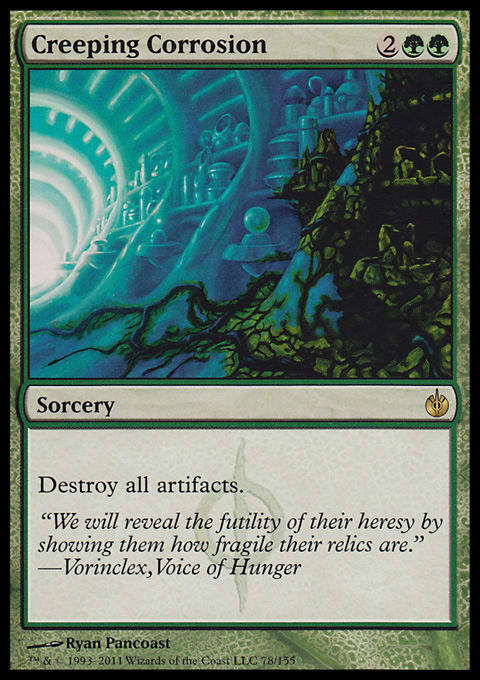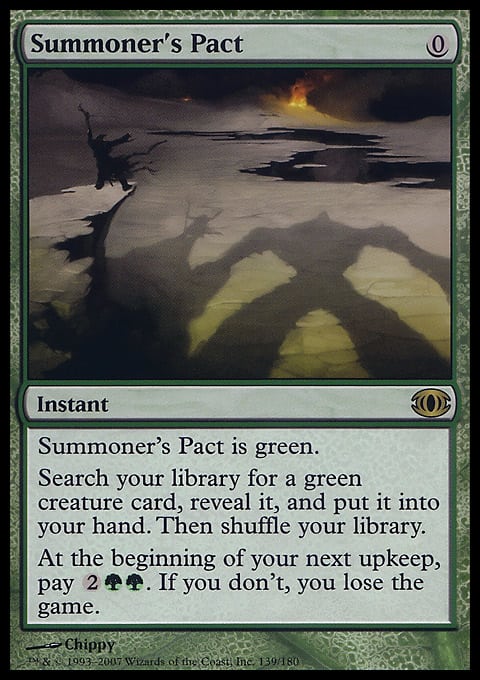The Eldrazi menace is real, and it’s going to be around until April at the very least. I’ve been pondering different ways of attacking the beast. With Eldrazi so fast, I want something can could win equally as quickly—or at least slow the game down with enough of an early board presence to take over. I want something that could possibly keep up with mana against the broken mana of the tentacled menace.
I went over some of the oldest, most broken decks in Grand Prix history, and one stood out: Grapeshot Elves that won Grand Prix Berlin in 2008. I also noticed Jesse Hill ran a Modern Elves as Pro Tour Oath of the Gatewatch that performed well. Jesse’s list is below.
Elves ? Modern | Jesse Hill
- Creatures (34)
- 1 Aven Mindcensor
- 4 Dwynen's Elite
- 4 Elvish Archdruid
- 1 Elvish Champion
- 4 Elvish Mystic
- 3 Ezuri, Renegade Leader
- 4 Heritage Druid
- 4 Llanowar Elves
- 4 Nettle Sentinel
- 1 Reclamation Sage
- 1 Scavenging Ooze
- 2 Shaman of the Pack
- 1 Spellskite
- Instants (8)
- 4 Chord of Calling
- 4 Collected Company
- Lands (18)
- 4 Brushland
- 3 Cavern of Souls
- 2 Forest
- 2 Gilt-Leaf Palace
- 1 Horizon Canopy
- 1 Nykthos, Shrine to Nyx
- 4 Razorverge Thicket
- 1 Temple Garden
- Sideboard (15)
- 1 Burrenton Forge-Tender
- 1 Chameleon Colossus
- 3 Kitchen Finks
- 1 Melira, Sylvok Outcast
- 1 Phyrexian Revoker
- 1 Fracturing Gust
- 3 Rest in Peace
- 4 Stony Silence
Jesse’s list tended to win by simply crushing an opponent between Ezuri, Renegade Leader and Shaman of the Pack. I wanted to leave less chance to combat, as I felt Eldrazi probably had the edge in speed. However, a Shaman kill could be relatively noninteractive against the eldritch ones, needing only to worry about Thought-Knot Seer.
The difficulty with Grapeshot Elves has been the loss of Glimpse of Nature and a number of enablers, such as Wirewood Symbiote and Birchlore Rangers. Beck // Call has often been toyed around as a substitute for Glimpse of Nature. It was Magic Origins that truly pushed the deck, as the printing of Dwynen's Elite does a good Wirewood Symbiote impression, and Shaman of the Pack straight-up replaces Grapeshot. Plus, Modern has a number of new tools to play with, including Collected Company and Cavern of Souls.
So I rebuilt Grapeshot Elves, using the tools at hand. Here’s the (almost) list.
The Devil?s Haircut ? Modern | Neale Talbot
- Creatures (32)
- 4 Heritage Druid
- 4 Elvish Mystic
- 4 Nettle Sentinel
- 4 Elvish Visionary
- 4 Dwynen's Elite
- 4 Elvish Archdruid
- 4 Llanowar Elves
- 2 Shaman of the Pack
- 1 Ezuri, Renegade Leader
- 1 Eternal Witness
- Sorceries (4)
- 4 Beck // Call
- Instants (4)
- 4 Summoner's Pact
- Lands (16)
- 2 Breeding Pool
- 4 Misty Rainforest
- 2 Overgrown Tomb
- 2 Cavern of Souls
- 4 Verdant Catacombs
- 2 Forest
You’ll notice that’s a neat fifty-six cards. So what’s missing?
There are two forks in the road here; and they look like this:
. . . or . . .
What’s the conundrum?
Sylvan Messenger has been surprisingly strong in testing, often drawing three or four Elves. This allows the deck to keep rolling through Beck; even three more Elves means a total of seven cards drawn if Beck is active. Sylvan Messenger also can be tutored for with both Pact and Chord, and it works with Heritage Druid to keep the mana chain going. Chord of Calling is a powerful tool for finding the exact missing piece required to either get the combo chain started (usually Heritage Druid or Nettle Sentinel), kept going (usually Dwynen's Elite or Sylvan Messenger) or ending it (either Shaman of the Pack or Ezuri). It’s also strong when you have a toolbox sideboard for individual matchups.
However, the consistency and power of Collected Company cannot be denied. It whiffs far less often than Sylvan Messenger, and it allows you to get around the black-mana requirement for Shaman of the Pack. It makes hitting an extra two cards off Beck relatively reliable. Occasionally, it will hit Eternal Witness, allowing you to grab Collected Company back again and keep going. And finally, in an attrition race, the card advantage—at instant speed—is great. Last, you sometimes happen to grab both Shaman of the Pack and the game ends there and then.
It’s a shame that Collected Company and Sylvan Messenger do not play well together, but the two are clearly mutually exclusive.
In order to come to some conclusion about it, I asked someone with intimate knowledge of the 2008 Berlin Grapeshot Elves list for help—someone whose name rhymes with Dwell Stress Free—for his advice. Here’s the main decklist he suggested.
The Devil?s Haircut (Acoustic) ? Modern | Dwell Stress Free
- Creatures (33)
- 4 Heritage Druid
- 4 Elvish Mystic
- 4 Nettle Sentinel
- 4 Elvish Visionary
- 4 Dwynen's Elite
- 4 Elvish Archdruid
- 1 Eternal Witness
- 4 Llanowar Elves
- 2 Shaman of the Pack
- 2 Ezuri, Renegade Leader
- Sorceries (4)
- 4 Beck // Call
- Instants (6)
- 2 Summoner's Pact
- 2 Chord of Calling
- 2 Collected Company
- Lands (17)
- 2 Forest
- 2 Breeding Pool
- 4 Misty Rainforest
- 2 Overgrown Tomb
- 2 Cavern of Souls
- 4 Verdant Catacombs
- 1 Pendelhaven
That signature Pendelhaven.
You’ll note that our mysterious benefactor added another land and another Ezuri, cut both Sylvan Messengers, and split Pact, Chord, Company at two, two, and two. My sense is it’s moving a little away from straight Grapeshot Elves (which also ran sixteen lands) with a safer backup plan. I would also say this, however: The man knows his Elves. Who am I to argue?
Running both blue and black gives us a number of options. Creeping Corrosion is a natural for the Affinity matchup. Ensnaring Bridge is also great against Eldrazi, as we can win with a well-placed Shaman of the Pack without attacking; plus, we’re relatively confident we can empty our hand if need be. Blue allows us to sneak in a Spell Pierce, a Dispel, and a Hurkyl's Recall. Black allows us to reach out to our opponent with Thoughtseize, Abrupt Decay, and the like. Choke is an equally fine hate card. Naturally, this runs to your meta and how you build the deck.
If you decide to go with the Chord option, a sideboard with a Dauntless Escort, Kira, Great Glass-Spinner, and Venser, Shaper Savant can be quite the surprise for your opponent, as can utility creatures such as Reclamation Sage and Kitchen Finks.
Whether you wish to retain the Melira-combo sideboard is up to you; certainly with Pact in the main, you can quickly chase down Melira and Kitchen Finks, and you’ll have the mana to cast a Viscera Seer. I haven’t tried it yet, but it seems to be a natural fit if you’re a transformative-sideboard kind of person.
Things to Remember When Playing the Deck
You are playing a combo deck. In other words, you want to go off at the last possible moment before dying. Occasionally, you’ll have a hand that encourages you to go off-plan, set up an early board state, and attack for the win. But you’d much, much rather wait until you draw a Beck // Call and then instantly kill your opponent.
The “god hand” looks something like: mana dork, Nettle Sentinel, Heritage Druid, Dwynen's Elite, Elvish Archdruid, fetch land, fetch land, fetch land. You’re almost guaranteed a turn-three win, and if you top-deck a Summoner's Pact, a Chord, or another Dwynen's Elite, you could even pull out a turn-two win, though it would be terribly aggressive to try.
A hand without a turn-one mana dork is fine if you have Heritage Druid and a Dwynen's Elite, as you may well bust out 5 mana’s worth of cards on turn two, which is keeping pace with Eldrazi at that point. Of course, this keep is very sensitive to removal, but we’re currently in a Bolt-light format, so it’s probably worth the risk.
While the deck is modeled on Grapeshot Elves, you are ultimately not playing Storm; if you have to win by going off for a turn and finishing up the game on the next turn, that’s perfectly fine. Storm count matters less than the number of Elves on the battlefield.
I’d recommend practicing gold-fishing with the deck about fifty-odd times before you attempt to play it. Knowing the sequences of when to Beck, Pact, Chord, or Company truly matters. Getting used to tapping Nettle Sentinel prior to casting spells, understanding how much mana is gained by a sequence of plays, and when to hold back a couple of Elves for a later-game Beck, is all valuable information. Once you have the sequences down, go into battle.
All that said, this deck is straight-unplayable if your meta is colorless Eldrazi with main-decked Chalice of the Void. You can try main-decking a Reclamation Sage, but by the time you’ve managed to find it or Chord for it, you’ll be so behind it’s not worth it. Once the colorless Eldrazi deck is banned in April—okay, assuming it’s banned in April—this deck will not have any major predators, and it will often be able to win well before the opposition.
Ultimately, this is a fun, fun deck to play. Right now, amongst all the tentacles, we have to seek the fun where we can.

























